Half Mile Cave 1960 - 1963
Experience of a Lifetime
by Audrey E. “Umpy” Osborn – March 2010
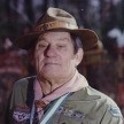 |
| Robert L. "Buddy" Irwin Eagle Scout Scoutmaster 1939 - 1990 |
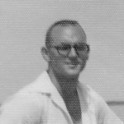 |
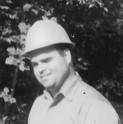 |
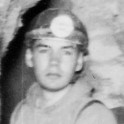 |
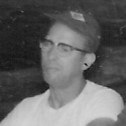 |
| Bobby Osborn Life Scout | Umpy Osborn Eagle Scout Asst. Scoutmaster |
James A. Moore Eagle Scout | Leonard T. Rovery Eagle Scout Asst. Scoutmaster |
Introduction
I joined Troop 97 in February 1950 along with my cousins, Kenneth and his twin brothers, Billy and Bobby Osborn. We had a fantasy to someday explore a cave. That July, while at Scout camp Kia Kima at Hardy, Arkansas, our dream was realized. Scoutmaster Buddy Irwin and Asst. Scoutmaster Dorris Goodman, a Kia Kima staff member, took the troop to Calico Rock to explore Bergman Cave. I would turn 12 later that month. That hot July afternoon, most of the Scouts were seriously apprehensive about entering the cave. One Scout could not complete the exploration past the water hazard mid-way through. My cousins and I were exhilarated after this experience and felt we had undergone some sort of a rite of passage. In a 1997 story about going through the cave in 1948, Colonel Dorris Goodman, Eagle Scout and decorated US Army Medevac Helicopter Pilot in Vietnam, had this to say:”That one adventure has been with me many times during my life. When uncertainty is facing you, sometimes the best thing to do is to keep on going forward.” That’s what my cousin Bobby and I did. We kept on going forward. In 1956 we explored Blanchard Springs Cave which is captured in my story: “Between Rock and Water”. Finally, my story, “Experience of a Life Time,” captures the ambitious explorations of Half Mile Cave in 1960-1961-1963.
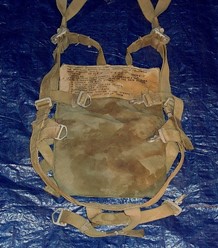
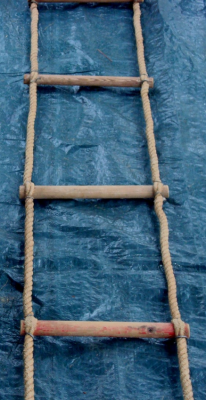
© 2010 All rights reserved. No part of this story may be used or reproduced in any manner whatsoever without the written permission of the author.
Half Mile Cave
1960 – 1963
Experience of a Life Time
Prelude
Two Thousand Ten is the 50th year anniversary of the beginning of exploration into Half Mile Cave (Blanchard Springs Caverns) and the first three expeditions that Post 53 and Troop 97 made to Half Mile Cave. These are the first words I’ve written expressing the impact this experience left on me and forty-five other Scouts and adult leaders.It recently dawned on me that all the Scouts we took on Half Mile Cave explorations in 1960, who are alive today, would be between 64 to 67 years of age. If any of these men were asked about Half Mile they would no doubt say it was the thrill of their life and how it has meant so much to them. Since the cave was opened, former Scouts on our expeditions have toured the cave and told the guide they were an early explorer traversing the pit by rope ladder or on a parachute harness attached to a block & tackle. They would describe their descent into utter darkness of the unknown and how the beauty and grandeur they saw in their dim cave lights was exciting beyond description and vivid even now in their memories.
It has been 50 years since Audrey E. “Umpy” Osborn 22, and my cousin, Robert L. “Bobby” Osborn 21, prior Scouts of Buddy Irwin’s Memphis, TN Scout Troop Ole 97, took their Scouts on expeditions into Half Mile Cave. We were then the current Scout advisors of Post 53 in Capleville, a suburb of Memphis. We had a group of about twelve active 14 to 16-year-old, red-blooded teenagers looking for adventure. Bobby and I had told the guys about our caving experiences with Ole 97 in the Calico Rock caves, Greer Springs and our exploration of Blanchard Springs Cave in 1956. We remembered the vow we had made that October, in 1956, to someday explore Half Mile Cave. All the guys wanted to visit Blanchard Springs and go cave exploring. None of them had ever been in a cave.
First Trip to Half Mile Cave - May 1960
May 1960 - My cousin, Bobby, and I took 10 Scouts from Post 53 to Blanchard Springs to explore Half Mile Cave. They were: Buddy Garrett, Charles Ashford, Sonny Jones, Bill Bentley, Eddie Harris, Bob Hardy, Ray Hardy, Jimmy De Grant, David Carroll and (?) Foster.
We entered the cave on a homemade rope ladder that we made at our Scout meetings. The ladder was 75 feet long, rungs were made from 12” sections of wooden broom and mop handles and were spaced 16” apart. We drilled a hole in each end, spread the one half inch sea grass rope apart, inserted the rung then secured the rung with a piece of wire through the rung and around the ropes. The ladder weighed about 25 pounds and was very functional with the exception we should have wrapped tape around the twisted wire ends. This oversight caused us much pain due to deep scratches on our hands and arms.
We were ready to tackle the 75-foot blockade of the stony mouth to the mysterious cavern. We rigged a safety line on a pulley that could also be operated from the cavern floor. This would insure against anyone falling off the ladder. Soon, we were all down, safe and sound, ready to depart our temporary base on the gravel below the entrance.
We had no idea what the next six or seven hours would mean to each of the ten Scouts and their two young leaders. I don’t know why but we decided to explore upstream. I guess Bobby and I liked the river because of our familiarity with Greer Springs in Missouri. Or, I think the main reason was we knew there wasn’t a connection with the spring. We had explored Blanchard Spring to its siphon in October 1956. That’s another story. So, instead of crossing the rapids into the breakdown room, we headed upstream. Soon, we exited from the ice cold water to the right into another huge room of the very large dry passage. It seemed like every few steps revealed something exciting. What is this; come over here; you “gotta” see this, was heard for the next 6 hours or so. I noticed one vast difference in Half Mile Cave in addition to its huge size; there were no or few foot prints and no paths to follow.
Even though we were tired, it was difficult to stop, take a rest or eat something. We wanted to press on to what lay beyond our feeble lights. I remember, we did stop at a tremendous column that now lay on its side near a hole in the ceiling revealing what appeared to be an upper chamber. This was a giant of a column and was a good place for us to rest. A gigantic dripstone curtain, beautiful beyond description, covering the entire wall, caused us to sit speechless in amazement. This would become the focal point of all that we ever saw in the cavern. This and other mammoth formations, even though still half hidden in our dim cave lights, would be forever burned into our memories. The huge passage ways and tremendous breakdown rooms were light years beyond anything we could have imagined. My favorite area was the crawl space around our blocked passage onto the ledge high above the Rocket Room floor. That is what is called the Christmas Tree Room today.
We wanted to leave some statement that we were there. A plaque, with everyone’s name on two 2” x 8” x 24” boards hinged like a book, was placed up stream in the main chamber beyond the Rocket Room. The plaque was placed on a slope where the main chamber joined the water far below on the left wall connecting the lower river level. The slope was getting steeper as we progressed and, as mentioned, no obvious path to follow. Without adequate safety ropes we decided to leave the plaque and exit this section of the cave for another day.
We returned to the forbidding entrance by the same way we entered. Amazingly, the return was as if we were in new territory. Almost everything looked different from the opposite direction. Remember our lights provided little more than enough light to plan where we would take our next five or six steps. The most drastic example of this was what we called the Rocket Room. This was because of a huge perfect cone shaped stalagmite. On the return from the floor of this room, it looked vastly different, a dead end! The ledge leading around and past the closure of the passage through the small crawl space was difficult to notice high up the right wall. It was in this crawl space that we encountered bats both entering and exiting. Numerous discoveries were made by our ten Scouts that day. I can hardly imagine how exciting this adventure must have been for them especially since it was their first time to be in a cave.
Climbing our rope ladder out at the end of our 7 or 8 hour ordeal was the biggest challenge of the entire cave expedition. I was glad we provided a safety line. We tied a rope line with a bowline knot around the chest and under the arms while climbing the 75-foot rope ladder. The safety line was on a pulley and helped greatly in our ascent out. I was thankful we all made it out without any mishaps. We were exhausted physically and mentally; it was great to be outside in the warm sun again.
It’s impossible to know the impact this cave expedition had on these ten 14 to 17 year old Scouts and their two young leaders. We also had no idea of the future impact of what we had just seen would have on Blanchard Springs and the Mt. View area. It was difficult getting transportation for ten boys and equipment from Memphis to Blanchard Springs. Cost for the 400 mile round-trip was near prohibitive for most of the boys and their two young newly married leaders. Nevertheless, we were committed to provide this high-adventure cave wonderland to as many of our Scouts as possible.
We all enjoyed our two nights of sleeping on straw at the Hunter Shelter on Green Mountain Road. I first saw the Shelter in 1958; 1960 was the first time to camp at the unique Hunter Shelter. This has been a tradition of Troop 97 for 50 years now. The current Scoutmaster, Mark Stroud, took Troop 97 to the shelter on January 15, 2010. Swimming at the Poag Hole on South Sylamore Creek was also a tradition started on this trip. We would hang our rope ladder off the cliff, jump in and climb up. That was a great experience for a Memphis Boy Scout Troop. We were looking forward to our next visit to Half Mile Cave, Poag Hole and the Hunter Shelter.
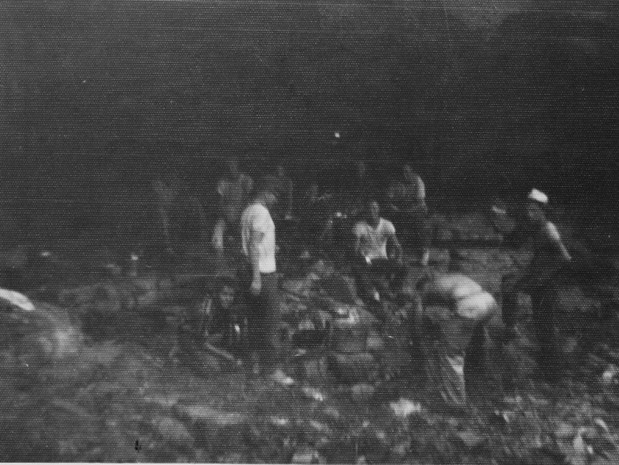
Poag Hole South Sylamore Creek 1960 - 1963
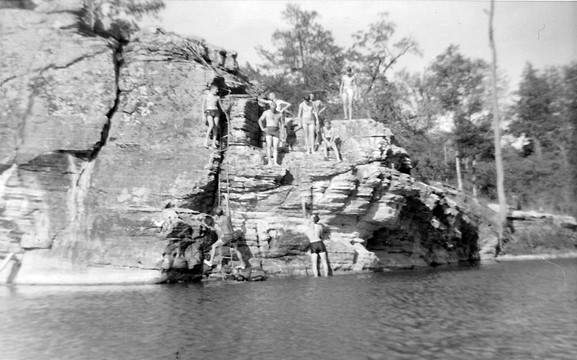
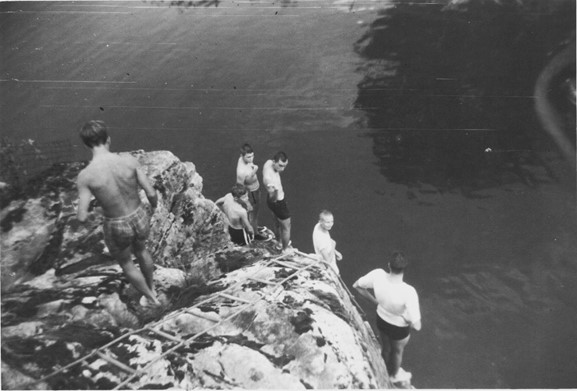
The Poag Hole was the perfect place for Troop 97 to camp and swim and we returned many times from 1960 all the way into the 70’s. Using our homemade Half Mile Cave rope ladder, we would climb up the bluff and jump in over and over again.
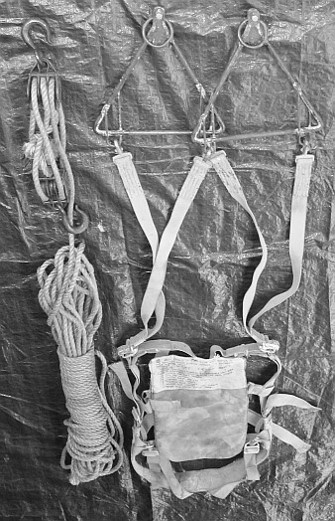
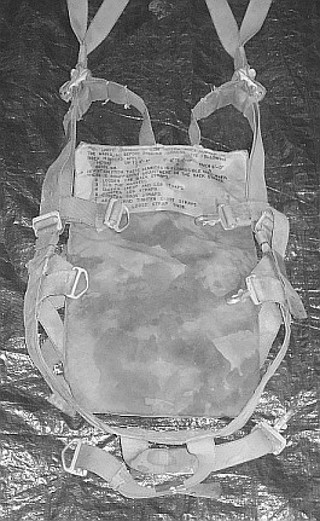
Second Trip to Half Mile Cave - July 1960
July 1960 - Bobby Osborn and a friend at the Tennessee Air Guard led another expedition to Half Mile Cave with Post 53. Bobby, his friend and I, rigged up a parachute harness attached to a block and tackle. This took a lot of planning and execution but made entering Half Mile Cave an exciting piece of cake. Just imagine buckling into an authentic Air Force parachute harness and sliding off into the awesome 75-foot throat of the cavern. All expeditions from this time on would use this method to traverse the 75-foot shaft. The same 10 guys were along on this trip. The route they took was the same as the May trip. I regret that I couldn’t join this expedition.
Third Trip to Half Mile Cave - Labor Day 1960
Labor Day 1960 - I would return with Buddy Irwin, Scoutmaster of Troop 97 and 22 Scouts. We brought with us, seven Post 53 Explorer Scouts: Buddy Garrett, Charles Ashford, Sonny Jones, Billy Bentley, Eddie Harris, Jimmy De Grant and George Ogden. The 15 Ole 97 Scouts included: Eddie Jordon, Jimmy Hembree, Kenny Poag, Larry Nance, Larry McPhearson, Jimmy Tunnell, Jimmy Dickson, Carrel Turner, Garland Massey, Calvin Cowan and 5 others.
We left Friday afternoon in the Ole 97 Scout bus, the “Swamp Fox”. Our destination was the gravel bar at the Poag Hole. We arrived that night at the picnic area before crossing the Allison suspension bridge over South Sylamore Creek. I showed our bus driver, James Shackelford, how to follow the creek up to the great gravel bar at the Poag Hole. As luck would have it, we got stuck in the gravel. We tried to push the bus through the loose gravel with no luck. Soon a man with a jeep showed up and pulled us out by using our 1” safety line. We wrapped the rope many times around the bumpers but by the time we pulled free the rope broke.
We were quite a large group: probably larger than what was practical for this age group in a wild cave. However, the Post 53 boys had made the descent twice before and most of the Troop 97 boys had been to either Roland Cave, Big Bergman Cave or caves in Missouri. To my knowledge, the majority of these guys had some experience in wild caves.
I went over the rigging up procedure again in the entry room. Soon, the safety line, pulley and block & tackle were chained to the walnut log boom over the stony throat of Half Mile Cave. We also attached our homemade rope ladder to the boom in case there was a malfunction with the block and tackle and also tied a one-inch safety line around the log boom. This line was tied to a tree outside and fed through an overhead crevasse. This was our rope the jeep used to pull the Scout bus across the gravel at the Poag Hole the night before.
With all the gear checked and accounted for, Charles Ashford, one of the Post 53 boys, was buckled into the harness. With both rope lines held tight, he sat on the rim of the cold damp mouth of Half Mile Cave and slid over the edge. In the blink of an eye, the four parachute straps were taut and with twelve hands working in unison, soon the first Scout was down, only 21 to go. Both rope lines would be operated from the gravel below after 15 of the Scouts reached the cavern floor. Another unforgettable Half Mile Cave adventure was under way. Fifteen more Scouts would be added to the incredible, once in a lifetime Half Mile Cave experience.
Knowing what was to be seen upstream, I couldn’t resist the need for the fifteen first-timers to see the marvelous diverse beauty that was in that direction. Exploring downstream would just have to wait for another day. So we explored upstream again. We went past the next breakdown room in the river for a short distance and because our legs were so cold we decided to come back to the dry cave and head toward the giant flowstone curtain.
This was my second visit to this vast section of underground treasure. This time I had twice the number of Scouts to keep up with. I knew each boy would be involved with many discoveries as well as personal testing. I remembered my time of testing ten years earlier, going through Big Bergman Cave at Calico Rock. I always thought of the experience as a right of passage. I knew in my heart, every one of these boys would have the same sense of discovery in this mother lode of discovery – mounds of bat guano, live bats and blind fish – nothing escaping their keen eyes.
Then suddenly, our dim lights focused on the left chamber wall covered with magnificent light tan flowstone. The first timers couldn’t believe their eyes. To me it appeared to be even larger and more beautiful than before. We had twice the light. Standing in cold silence, I had a feeling of reverence and finiteness in the presence of God’s beautiful creation.
The tremendous travertine dam was classic and we spent a great deal of time looking over every inch of this area including the wet floor and the many stalagmites in this area where one of our few cave pictures was taken. On to the Rocket Room, the Troop 97 boys thought the passage was tightly sealed shut from floor to ceiling with smooth flow stone. The group stood in silent disappointment until I suggested they take a close look at the left wall. They soon found the small crawl space under the ledge around the blockage. This was one of my favorite parts of the entire cave. Their excitement in finding the crawl space was the same as ours four months earlier when we crawled through for the first time. We were suspended on a ledge high above the floor looking down on beautiful monstrous stalagmites, one we called the rocket. Therefore, we called this room the Rocket room. We continued to the far end of this room and decided to rest, snack and focus our attention back toward the entrance. We sat for some time in total darkness and silence. This is always impressive for first timers. I always liked to ask what they heard and how it felt. They all decided there was a lot to hear deep inside a cave.
I wish we knew the number of large formations from this point to the entrance. I don’t know but I do know our 28 Scouts and leaders in 1960 added a lot of footprints and hand prints in this vast subterranean world in the limestone rock beneath the Sylamore hills. Each Scout measured, felt and catalogued in his memory the height, breadth, shape and color of all that they saw, climbed over or touched. It was rewarding, listening to the numerous comments of discovery and exclamation from the guys. We had no thought that our eyes were some of the first ever to behold this breathtaking underground creation. Soon, we were climbing through the last breakdown room to the river.
We hated to leave all that we had just discovered but standing on the wet gravel in the cold, damp, cave air made the bright sunlight 75’ above look pretty good. Everything was in place; all the ropes, pulleys, ladder and parachute harness. With all parts in working order and both ropes below, we were ready to start our ascent. We operated to one side of the opening. This helped protect the rope handlers from possible falling objects. We would have at least six hands on each rope at all times. Actually, the trip up was quite routine except for the person in the parachute harness. The ride up took around five minutes or so. We would then pull the empty harness back down with a lightweight cord. With only three or four cavers left below, both ropes would be operated from the cool damp rock of the entry room floor.
With everyone out, it was breakdown time, roll the ropes and dismantle equipment, move out of the entry room and hike back to the spring. We were too busy and tired to talk much about the last eight or nine hours. We were just glad to have made the effort and were all out and safe. Talking about the many wonders we saw and challenges we faced would come later. At this point, I would be thinking about when we might be able to return.
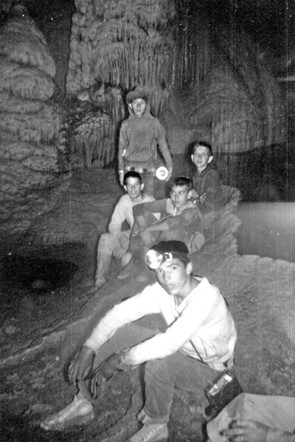
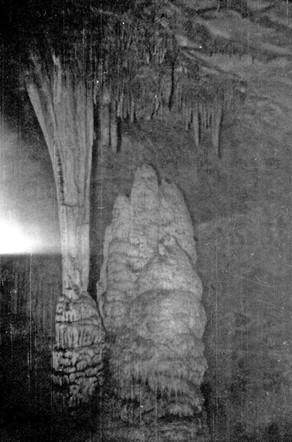
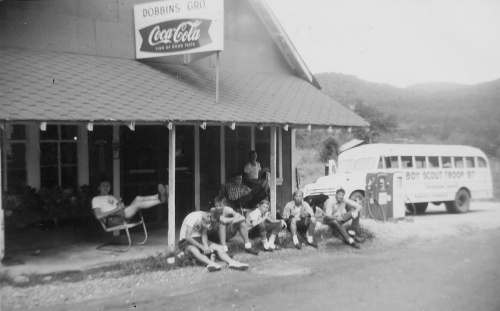
Dobbins Store on Highway 14 at Allison was a favorite place for Troop Ole 97 to get drinks and snacks. The Ole 97 Bus, “Swamp Fox”, gassed up ready to load and head to Memphis, Tennessee.
Front Row: Jimmy Dickson, Carrel Turner, Bobby Spears, Leonard A. Rovery, Charles Ashford – Back Row: James Shackelford, Jimmy Tunnell, Terry Denson - Not Pictured: Leonard T. Rovery, A.E. “Umpy” Osborn
Entering Half Mile Cave - June 1961
Ernie Roberts has the parachute harness buckled on, notice the shoulder straps.
The rope from the top of the picture is a safety line tied to an outside tree to help secure the log boom.
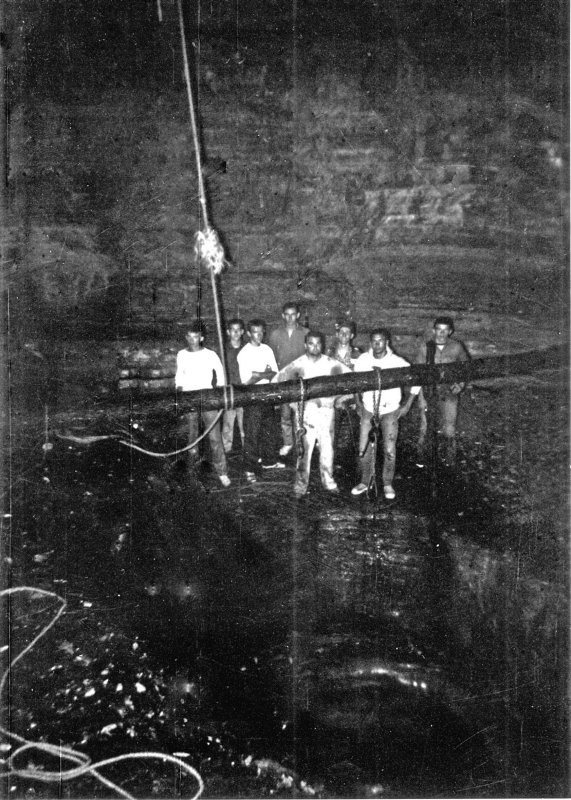
Fourth Trip to Half Mile Cave
June 1961- from Kia Kima
June 1961- Troop 97 took another expedition to Half Mile Cave. This would be my third visit to Half Mile. This was a day trip from Boy Scout Camp Kia Kima at Hardy, AR. Jimmy Moore, Ole 97 Eagle Scout and camp staffer and I, along with Jimmy Dickson, James “Ernie” Roberts, Larry Nance, Carrel Turner, Jimmy Tunnell, Kenny Poag, Bobby Spears, Jimmy Hembree and all our caving gear, left camp after breakfast in Buddy Irwin’s pickup. We made dust fly the 80 or so miles through Calico Rock to Blanchard Springs.
Seven of us were veteran Half Milers but Jimmy Moore, Ernie Roberts and Bobby Spears were first timers. Jimmy had been in numerous wild caves including several times through Big Bergman. I felt we would have the experience and stamina to take a closer look at side passages we had previously seen but did not have time to explore. We had two meetings at camp about rigging up and everyone knew their part well.
We were up the creek and in the entry room before 11:00 a.m. We slammed the rigging like a core of Army Rangers and were ready for Ernie Roberts, a future West Point Cadet, to buckle on the parachute harness. Our crew was ready to traverse the stony throat of Half Mile Cave for the fourth time. We looked up and there outside watching us was a girls Sunday school class from North Little Rock. To my knowledge, they were the only outsiders to ever observe our entry. Each one of us got a close up look at the smooth cold limestone walls of the cave entrance. Planning and experience paid off, we were down in fast order.
We had already made plans to go back upstream via the mammoth flowstone curtain. This would be my third trip in this direction, twice for five guys; the other three Scouts were anxious to see the famous flowstone formation. It seemed to be a magnet always drawing us back to her. We also planned to find a way into the mysterious upper chamber, the one you could see near the Fallen Giant and also any other side passages.
We went upstream this time by crossing the river into the main chamber across from the entrance instead of wading-up river and entering the main chamber. This appeared to be the route others before us had taken trying to keep feet dry by jumping from rock to rock. If I knew then what I know now we would have definitely explored in the downstream direction but, I say it’s all good.
Soon, we were near the marvelous flowstone curtain. At first glance in the dim light something looked different; then it came into full view, a full size yellow Shell Oil sign. I imagine some group worked hard to get the large sign into the cave. Stringing it up in the middle of one of the signature formations of Half Mile Cave seemed odd. We were disappointed that someone would deface such a glory of nature.
We fulfilled our plan and found a way into the upper chamber and came too close to walking into the oval hole in the floor. We explored several passages and turned back with no end in sight. In one of the passages we found numerous helicities. Some had horizontal crystals curving around a vertical stem. We eventually got tired of new passages and decided to call it a day. We were able to take a few treasured pictures on this trip.
About seven hours later, we were back at our base below the entrance; we were ready to call it a rap. The filtered sunlight 75 feet up was now our goal; it had been a long day. Heave ho on the ropes, make the tackle spin, hang straight and enjoy the ride up to the lip of the stony throat. Break down the gear part by part and only one-half mile to carry the 43 or so pounds of gear to Buddy Irwin’s pickup. We washed up and made it to Rosa’s Crossbow Restaurant. Now, for the long slow trip back to Hardy. We talked Virgil Thornley, the Calico Ferry operator, into taking us across on the ferry after it had closed for the night. Just another 45 miles of gravel road on to Kia Kima, arriving after midnight. It was a long and very exhausting but unforgettable day.
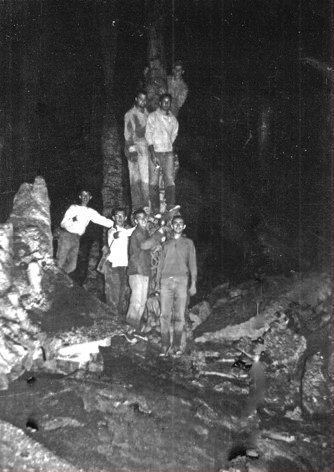
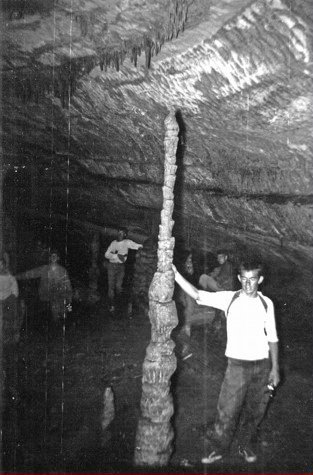
Fifth Half Mile Cave Trip
July 1961 with Kia Kima Staff
July 1961 – Jimmy Moore and Jerry Robinson, Troop Ole 97 Scouts and BSA Camp Kia Kima staff members, returned with five fellow staff members to explore Half Mile Cave. They were: Rick Phillips, Pug Swarner, Bill Denman, Bill Harrison and Steve Demster; all Memphis Scouts from other troops. At eighteen, Jimmy Moore was the youngest to lead a Half Mile Cave expedition. Both he and Jerry Robinson had previous wild cave experience but this cave trip was a new experience for the other five.
As had been previously done just a few weeks earlier on the June 1961 exploration, they would follow the route on the level that is today named "The Discovery Trail". It covers 1.2 miles of the lower sections of the cave, 366 feet underground and features one of the largest flowstones in the world -- some 140 feet long and 40 feet high. Underground stream, unique formations and the natural entrance to the cave are some of the breathtaking highlights of this route.
The week before their trip, all ropes and equipment were checked and the six soon to be new cave explorers were briefed on why and how it was needed. Nevertheless, when in the entry room, the phrase 75-foot natural cave entrance takes on a personal meaning. Honestly, it is a somber scene and was reflected in the timbre and body language of the five novices. To a 20-year-old, would-be cave explorer, it was like looking into an intimidating mouth of a bottomless pit. After a quiet but skillful job of rigging, each one was coaxed into the parachute harness, attached to a hand operated block and tackle and sent on his slow journey to the cave floor, probably the most apprehensive 75 feet of their young lives.
With 14 feet firmly planted on the wet cave gravel, the six first-time Half Mile Cave explorers were introduced to the new and fantastic cave geography that lay before them. Five of these seven Kia Kima staff members were over 20 years of age. This was quite different from the usual 14 to 16-year-old Scouts. They crossed the river into the large breakdown room opposite the entrance making an effort to keep their feet dry, although it just takes up more of the time that you have in the cave.
Immediately when entering the room, they were blinded by the vastness of what lay ahead. Their trusty lights in reality cast little more than a shadow. It took some getting used to. They had no idea the work involved and the attention required for just where the next step would be taken. Soon they were acclimated and enjoying this immense and wondrous cave scape. Adrenalin was flowing, magnifying every new thing in sight; beautiful cave formations and gigantic stalagmites reaching toward the ceiling somewhere high above.
In the chilled cave air their sweaty bodies were steaming and in the dim light the delicately beautiful flowstone curtain appeared before them. However, once again the Shell Oil sign was a hindrance to its full measure of beauty. We couldn’t understand why it had been hung as to obstruct the glory of this beautiful formation.
Each of these young men enjoyed this new world in the context of their own point of view. As a misstep by Billy mired him knee-deep in a large deposit of guano; Pug as a medical student, was concerned about the possibility of diseases spread by bats. Thus, not unlike the other explorations, every turn and step sparked a new comment of wonder and exclamation. Searching behind the travertine dam they were looking for any sign of aquatic cave life. Through vast passages filled with gigantic formations, old as time, and crawling through to the Rocket Room, they were able to observe a bat colony clinging to the high ceiling of the cave.
Hours ticked away and, too soon, it was time to return to the entrance. In retracing their steps they had one last chance to have a second look, to remember the details of all they had experienced. With each step, fatigue was beginning to speak in a soft voice but they pushed it aside for one last look. On reaching the stony entrance all were ready for the warm sun to kill the chill in their tired bodies.
Everyone was accounted for and ready for the challenging ride to the surface. It had been a tiring eight hours or so since they entered the cave. In the dim light they could barely distinguish the log boom from the gray rock. It looked like a long way up. Each had their turn in the harness and their turn with a "heave, ho" on one of the ropes. Soon, the last Scout climbed out of the stony cave mouth. Everyone that day found victory in the many challenges of Half Mile Cave and memories to last for a life time.
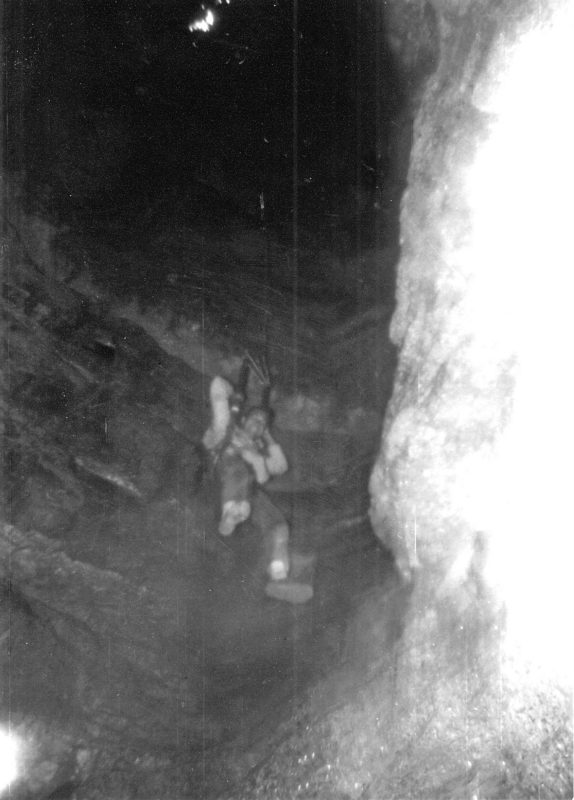
Sixth Trip to Half Mile Cave - Labor Day 1963
Labor Day 1963 – This was the last expedition Ole 97 Scouts would make to Half Mile Cave. Leonard T. Rovery and I took ten Scouts with us; it was my fourth trip to Half Mile and Leonard’s second time in a cave. I was excited this great Scout leader was with us; he was skilled in both Army and Scouting survival. What can I say? He survived the Normandy invasion! This last crew consisted of my cousin “Buddy” Osborn, Jimmy Dickson, Leonard A. Rovery, Mike Brown, Terry Denson, Glynn Castle, Jack Bishop, Bob Spears, John Berry and Charles Ashford, a Post 53 Scout that made several cave trips with Troop Ole 97 and was our group photographer.
It was a beautiful day in the Sylamore. We always looked forward to swimming at the Poag Hole almost as much as camping at the Hunter shelter. This would be our camp for the next two nights. We headed out to Blanchard after breakfast and were soon climbing down into the entry room. We were surprised to see a winch attached to the log boom. The winch was outfitted with what looked like quarter-inch wire rope. We assumed the forest service was at work in the cave somewhere. For the last time, we attached our lines to the log boom. Such excitement slipping off the stony ledge with a jerk of the parachute harness and a measured descent as our sea grass rope was fed through the block and tackle. It’s an understatement to say it was a unique and exciting entry into the timeless world of Half Mile Cave. Even sounds of the rushing river and voices of the crew in some way seemed to be different inside this massive cavern.
Another Ole 97 expedition was underway. Our plan was to go down stream and, if time permitted, we would go back up stream as well. We packed up and left the dim light of the 75-foot entrance and crossed over the river into the large breakdown room and continued up into the passage to the right. This was the first time for our expedition to go in that direction.
I can’t describe anything in detail until we reached the huge breakdown room. It was as if this portion of the cave consumed all my memory of what lay between the entrance and that room; a room so large that our most powerful light beams would only make a dim spot on the distant wall. We could see the water far below and to the right. A vast chasm lay between us and what looked like the main passage on the far side and near the ceiling of the room. There appeared to be no easy way up the tremendous breakdown slope ahead, no path of any sort to the continuation of the main passage.
We slogged our way up the spiteful slope, step-by-step to a beautiful tunnel-like passage you could drive a bus through. Soon the easy walking came to an end when the passage was terminated by flowstone that totally filled every crack and crevice of the passage. Our return soon brought us back to the brink of the tremendous breakdown room. Which route down should we take?
I wanted something easier than our climb up that mountain of loose rock slabs. I chose a route down near the right wall. I remember loose rock continued on up to crevices toward the ceiling. I was in the lead picking my way slowly over each loose slab. I had never experienced breakdown quite like this before; everything was so unstable. Near the top, moving slowly, I stepped off of a large flat rock and immediately felt the boulder tilting over. I moved to the edge of the lower slab and felt the large rock skin down the back of my high top leather boots. Luckily, the rock bounced to the right and catapulted over and over for what seemed like forever to the bottom of the chamber. I never heard such a sound in my life. This was the only close call for us ever; I was glad it happened to me and not one of the boys.
Soon, we were passing the entrance; our ropes and parachute harness were in order, awaiting our return. We had seven first-timers in our crew, anxious to see the other part of the cave they had heard so much about. I was eager for them to see the great flowstone curtain. This would be the last time I would see the superb formation for many years. Much to my relief the Shell Oil sign had been removed; the stony curtain now flowed in its pristine glory. It was hard to say goodbye.
More eyes would see and hearts would beat with excitement in every breathtaking turn in this colossal underground environment of eternal darkness. We moved on for the benefit of our seven first-timers to experience what 38 other Scouts had already seen. I did one original thing in this area of the cave. After crawling into the Rocket Room for the last time, we went into the upper chamber and left a small candle lit near the oval hole in the floor. When returning to the entrance, we turned our lights off at the fallen giant and took our last rest in candle light. This was the second wild cave that the Rovery’s, father, 50, and son, Leonard 15, explored. Both were bitten by the caving bug and continued Troop Ole 97’s cave exploring legacy for years.
Another fantastic nine-hour cave adventure was now completed and only the ride up in our homemade elevator remained. I knew this was goodbye; the cave would be closed. Buckled in, the first caver slowly ascended the 75-foot stony portal to the outside world. Each rhythmic pull on the block and tackle brought each of us closer to our destination. Soon, everyone was safe on the stony deck. It was now finished, only to live on in our memories, each in his own way.
Robert L.”Buddy” Irwin, Audrey E. “Umpy Osborn, Robert L. “Bobby” Osborn, James A. “Jimmy” Moore and Leonard T. Rovery were responsible for 45 Scouts and leaders to help make original foot paths in Half Mile cave, 15 were Eagles Scouts. It was exciting to be one of only a few to experience this majestic wild cavern and play a part in its early history, 1960 - 1963.
Half Mile Cave Crew
camped at the Hunter Shelter - 1963
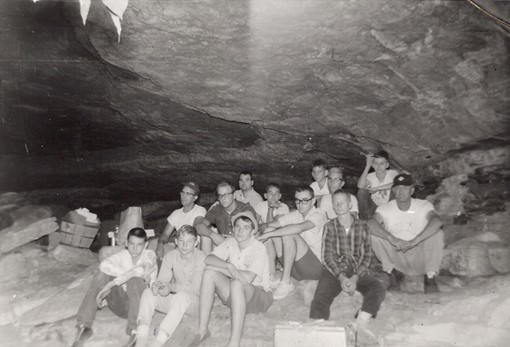
Epilogue
By: James A. Moore
In reality only a very small number of people were able to conquer the challenge and danger of getting down the straight walled shaft to see “Half Mile Cave” in its pristine “wild” state as we did. Already, the window of opportunity was beginning to close on accessing the massive caverns at Blanchard Springs. Labor Day 1963 was Troop 97’s last Half Mile Cave expedition, and on the heels of their last footsteps, Half Mile Cave was about to undergo a dramatic transformation. All total, 45 of our Scouts left their footprints in Half Mile Cave and as such they deserve a “footnote” in the caverns’ early history.
Shortly afterwards, the Forest Service closed it down, restricting access to the natural opening to the shaft. A 1964 article appeared in Life magazine featuring a full-color photo layout of Blanchard Caverns spectacular formations, referring to it as the "cave find of the century." By the time the articles and pictures appeared, plans were underway to develop a trail through the upper chambers. The caverns were re-opened to the public in July 1973 after ten years of development intended to tame the cave and prepare it for US Forest Service controlled access by the public. At that time, Blanchard Springs Caverns got its new name from the cave’s underground river exit, Blanchard Springs. “Half Mile Cave”, the original name used by locals and spelunkers, was dropped from usage.
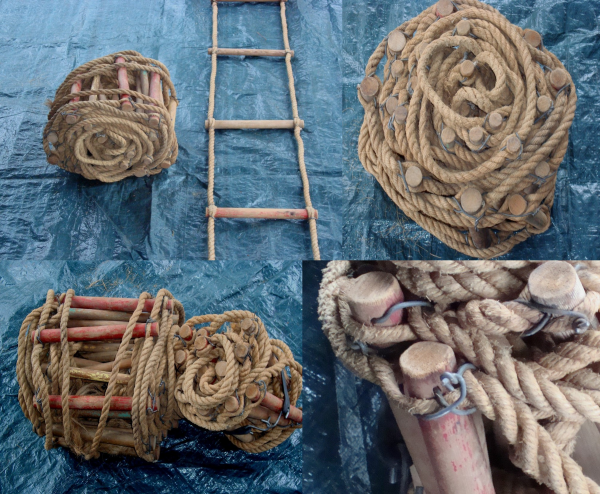
Story and pictures by Audrey E. “Umpy” Osborn, Ole 97 Scout 1950, Eagle Scout 1954 – Written March 2010